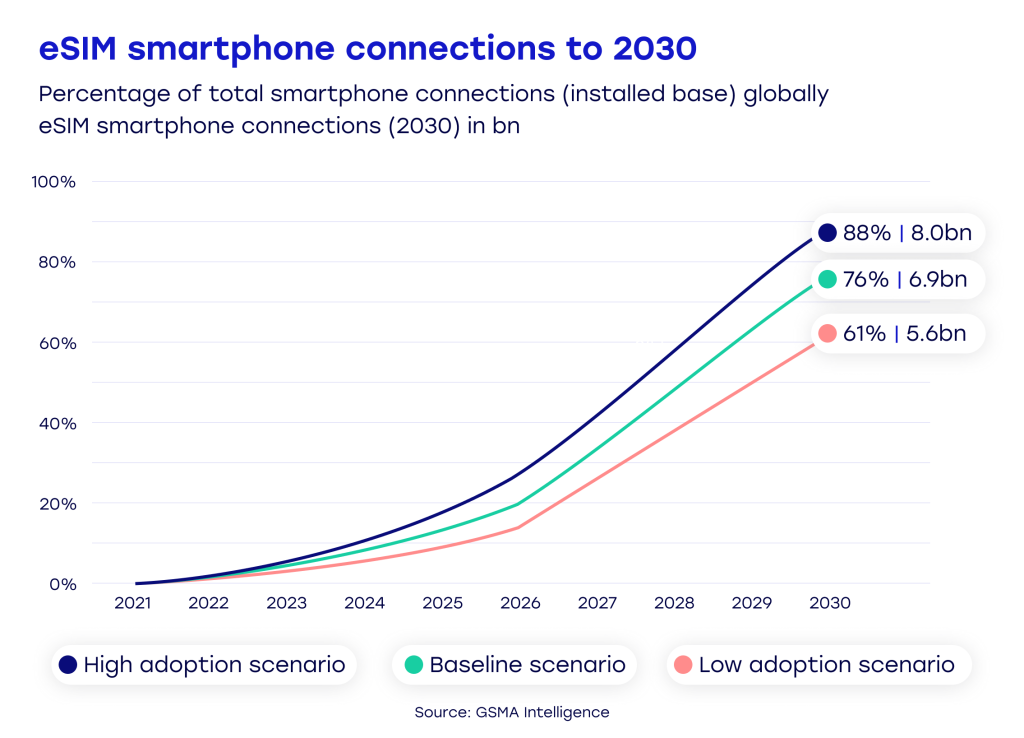Helmes has more than 20 years of experience developing business-critical systems for telecom companies in Europe and beyond, serving millions of customers with digital infrastructure and services.
For nearly a decade, we have partnered with a telecom company to implement innovative eSIM technology. From the beginning, Helmes has served as the company’s development and integration partner for this technology.
A Revolution in the Telecom Market
An embedded SIM, or eSIM, is a small electronic chip built into a device, functioning just like a physical SIM card. It enables users to easily activate a digital SIM and switch between different call and data service providers. It is incredibly convenient when traveling but also beneficial in other situations.
The SIM card landscape has largely remained the same since the 1990s. However, the introduction of eSIM technology presents the potential for a significant transformation in the market. This advancement is not only technological but also enhances the user experience with mobile services and disrupts current business models. For example, local and regional eSIM cards are set to partially replace traditional data roaming. At the same time, the eSIM will open new possibilities for “Try and Buy” mobile services campaigns and the Internet of Things (IoT) field.
Moreover, eSIM technology radically facilitates connectivity for many other devices besides mobile phones, such as laptops, smartwatches, and IoT devices, from smoke detectors to smart cars. It is foreseen that eSIM technology will completely replace physical SIM cards in the next decade, bringing along major changes and many opportunities for service providers. Already in September 2022, models launched in the U.S. by Apple came without a physical SIM tray, and they support only eSIMs.

A Connecting Block for a Complex Ecosystem
The technology of the e-SIM depends on multiple stakeholders: device manufacturers, eSIM vendors, mobile operators, and end customers. As our Client’s development partner in implementing eSIM technology, Helmes’ role has been to connect the different parts of the complex ecosystem.
Our collaboration in implementing eSIM technology has focused on two primary directions:
1) A central eSIM integration platform
We have developed a central eSIM integration platform that integrates with eSIM vendors and our Client’s digital sales channels, apps, and self-service platforms. Thanks to the platform, customers in different markets can easily install, activate, and use eSIM services. The integrations with eSIM vendors follow the latest GSMA-specified industry standards (ES2+ interface, TS.43 standard).
2) On-device services
Our goal is to offer customers a simple solution for installing and activating eSIM service on their devices. The user experience is crucial; customers should be able to start using eSIM services with the help of their mobile phone within a couple of minutes without having to visit the store or contact customer service for assistance.
Today’s most common eSIM-compatible consumer devices are smartwatches, including children’s watches, tablets, laptops, and smartphones themselves. The integration projects require close collaboration with global device vendors, like Apple, Samsung, and Microsoft, to ensure that the user experience is aligned with the manufacturers’ requirements.
Examples of Launched Services
Smartwatches
After purchasing a smartwatch, customers are prompted to enable mobile connectivity and install the eSIM service. They have the option to use their existing phone number (known as the one-number service) or select a different number. Once the eSIM is activated, the smartwatch can be used to make and receive calls and perform other functions, such as listening to music, geolocation, and activity tracking. Different integrations are required for each device. Helmes has completed integrations for Apple and Samsung devices.
Laptops
The number of laptops with eSIM support is increasing, primarily aimed at business customers. The integration projects are carried out in collaboration with Microsoft. Helmes has completed integration projects for both Windows 10 and 11, allowing customers to share mobile data buckets with their laptops.
Apps
Increasingly, eSIM user services are being integrated into apps. Currently, we have added eSIM functionality to several self-service applications.
A Product Team Working in Tandem with the Client
The basic functionality of eSIM for customers was launched in 2016. Since then, we have been introducing new services and expanding into additional countries as part of our ongoing collaboration with our Client.
Helmes has a dedicated product team of twelve members (and counting) working on the project. As telecom companies have specialized competencies, our team collaborates closely with our Client and device vendors. In total, the extended project team involves approximately 18 people working as a distributed virtual team across several countries.
At Helmes, we follow an agile and flexible development process. Every three months, we review the roadmap with our clients and establish goals for the upcoming quarter. We then collaborate with colleagues from various countries to further refine development goals in different markets.
Helmes as an Innovation Partner
The eSIM technology has come to stay, inevitably changing how people buy and consume mobile and data services. Changing user behaviour holds challenges for telecom service providers but also new opportunities, particularly in IoT data services.
Helmes has been developing eSIM solutions for eight years, during which our dedicated team has completed more than 15 eSIM integration projects. We have experience in industry-standard integrations, including the GSMA ES2+ interface, the TS.43 standard, and proprietary entitlement implementations for Apple and Samsung, working with different eSIM vendors. Additionally, we specialize in designing customer-friendly eSIM services that are easy to use and align with device vendor guidelines, making it simple for customers to adopt this innovative technology.
If you’re interested in learning more about our eSIM capabilities or exploring custom solutions for your organization, don’t hesitate to get in touch with us.
Get in touch

